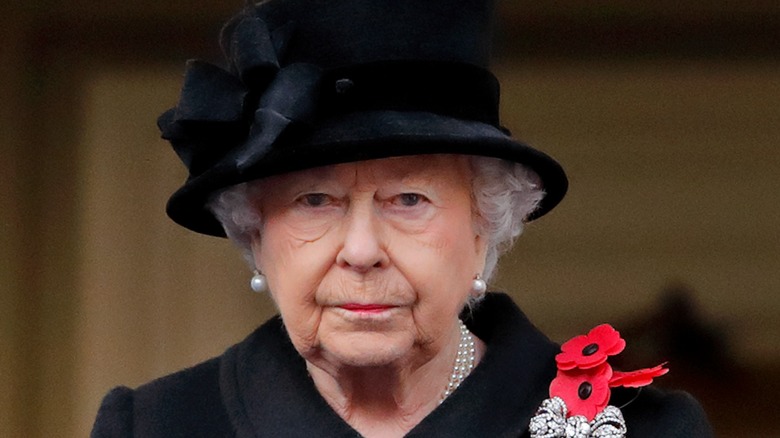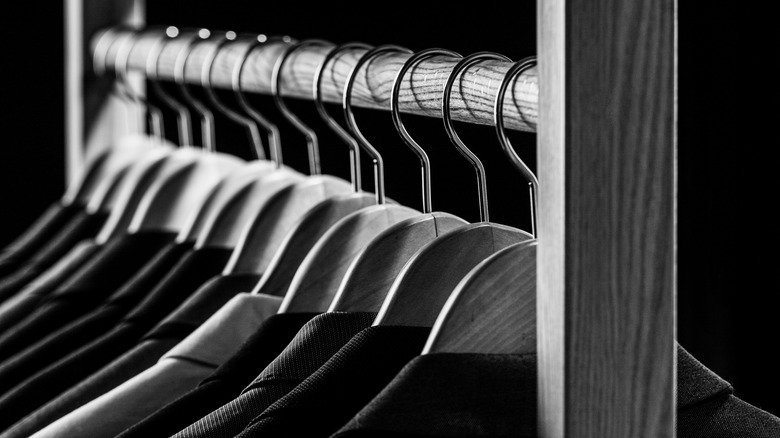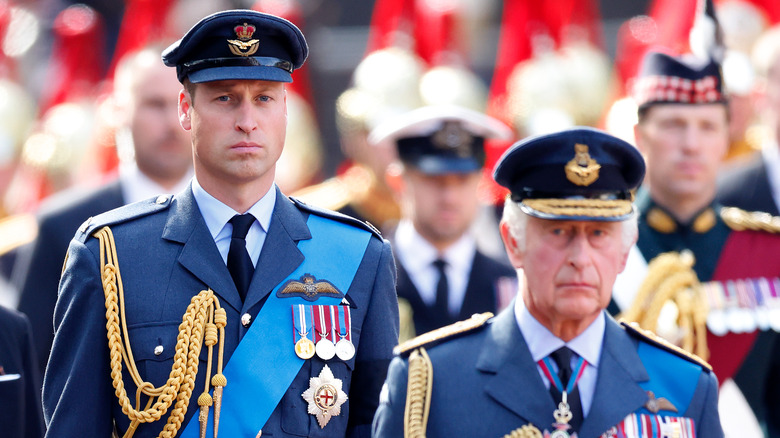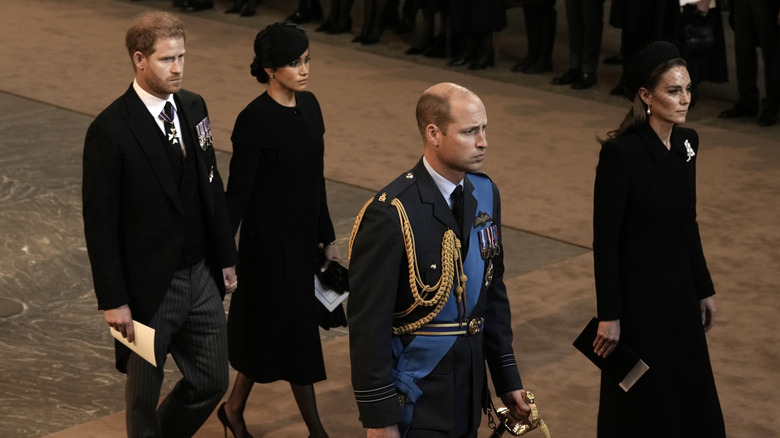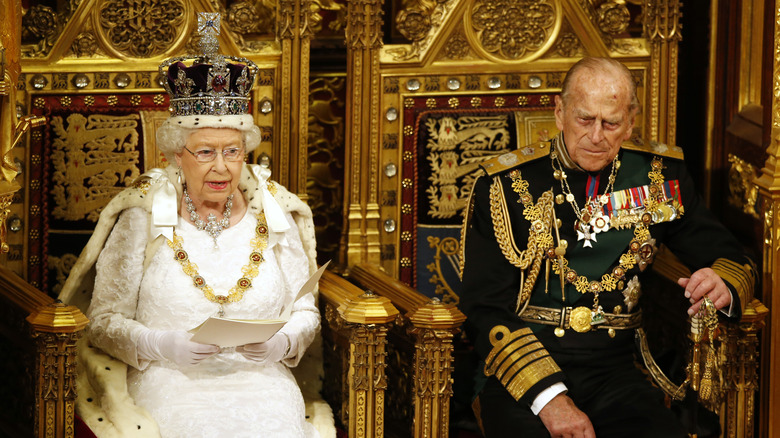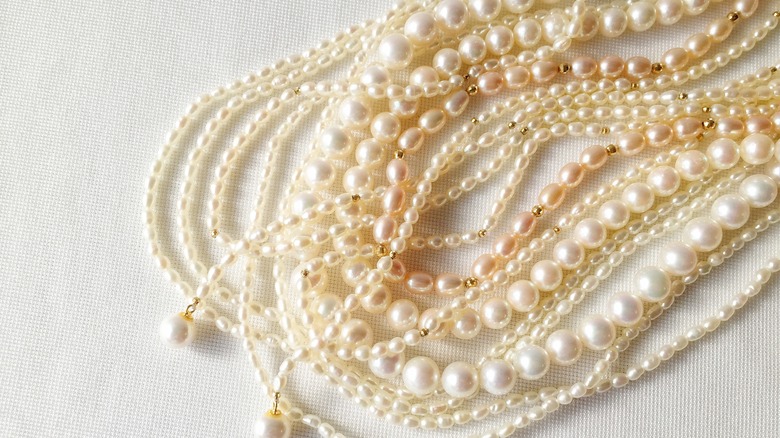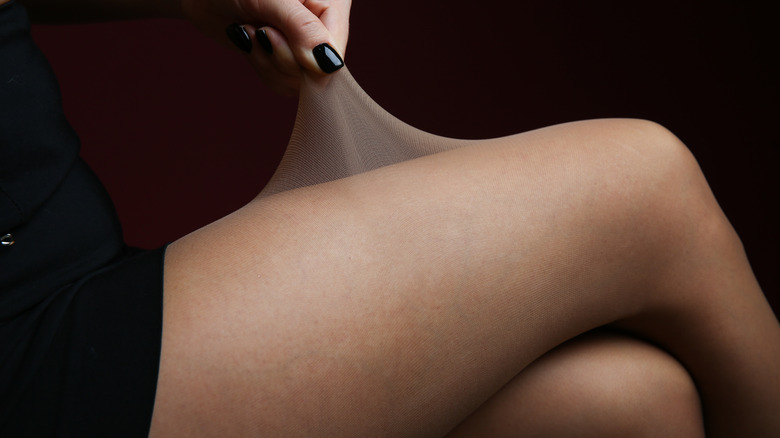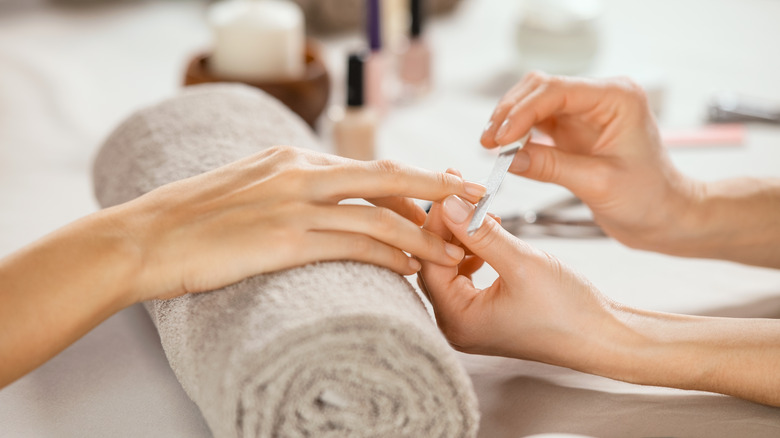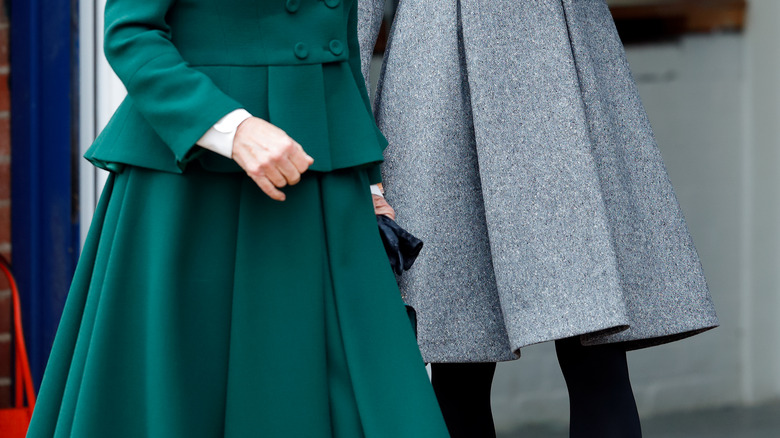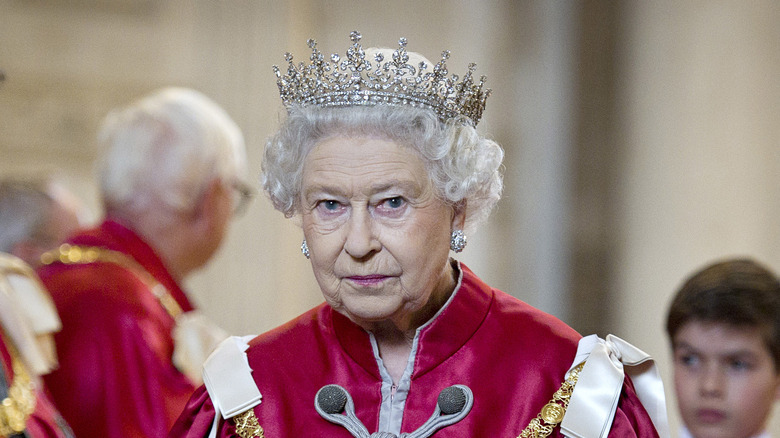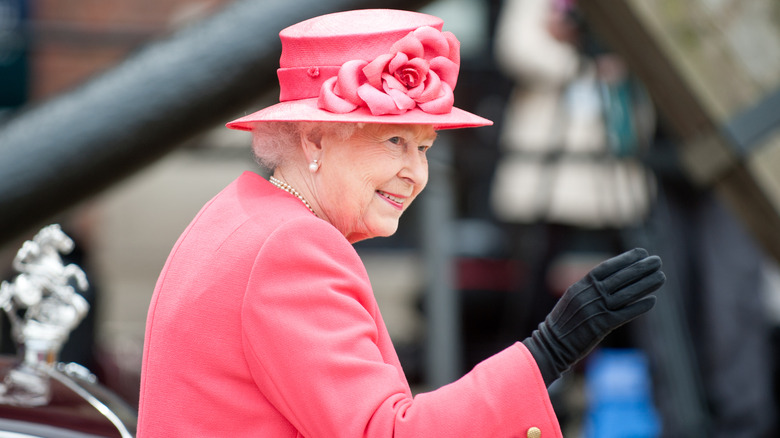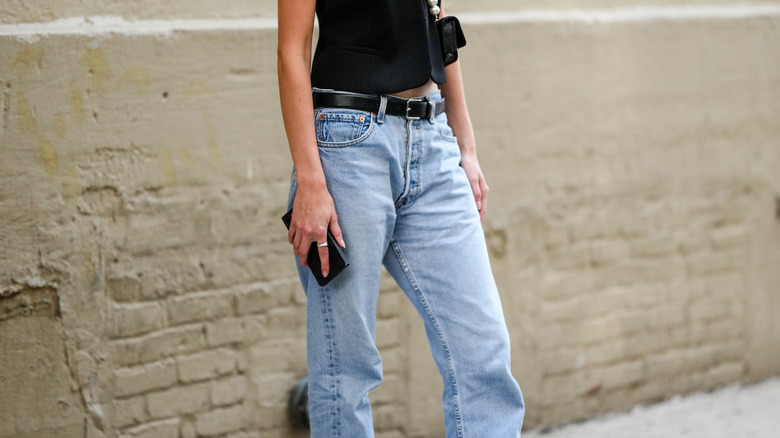The Strict Dress Code Royals Need To Follow At Funerals
Many royal funerals have been held in Westminster Abbey, and one thing they all have in common is that they're incredibly elaborate. According to Westminster-Abby.org, some of the major royal burials in history have taken place for kings, queens regnant, and queens consort. Business Insider describes royal funerals as "a big and complicated business" in the United Kingdom, with the challenge of maintaining a balance of tradition and modernity.
One detail that has remained more or less the same over the years is the royal dress code for funerals. There are several strict rules that members of the royal family are supposed to follow as they honor loved ones who have passed away. Queen Elizabeth II died on September 8, 2022 after ruling as the monarch of 15 countries in the Commonwealth for 70 years. Her death has sparked conversations about what the royal family is supposed to wear when at funerals and during official periods of mourning.
The Evening Standard revealed that BBC presenters switched into black suits and clothing when the news of the queen's deteriorating health started to spread. As presenters proceeded to share rolling coverage and updates leading up to her death, black clothing was respectfully worn by nearly everyone on camera. So, what is the royal family supposed to wear? Read on for some strict dress code rules that have been followed at funerals throughout history.
Non-military members of the family wear black
Members of the royal family who have not served in the military will likely wear black, according to WIO News. Generally speaking, black is the most common color to wear for people who are in mourning, and the tradition has been around for centuries.
According to Stark Funeral Professionals, wearing black to funerals is considered a sign of respect to the one who passed away. The tradition has been in motion since the ancient Romans. During their era, they would wear dark-colored togas to let others know they recently lost a loved one. When the ways of the Roman empire began spreading throughout Europe, this particular tradition spread along with them. Other cultures noticed the theme of black clothing at funerals and began adopting the style. Interestingly enough, wearing black clothing at funerals during the Middle Ages represented opulence and wealth.
Wearing black to a funeral isn't totally mandatory, and there are other alternatives one might consider. Dark gray, deep blue, and brown are some of the other popular options. Bright and cheerful colors such as yellow, orange, or pink should definitely be avoided at any funeral (unless otherwise specified) since death is never considered lighthearted or exciting. For these reasons, black clothing for non-working members of the royal family is definitely the standard.
Working members of the family wear military uniforms
When it comes to royal funerals, all working members of the family are supposed to wear their military uniforms. CNN originally said that Prince Harry and Prince Andrew would not be wearing their uniforms at the queen's September 19, 2022 funeral, despite the fact that they are the only two living members of her immediate family who served at war with the military.
In a stunning twist of events, King Charles III authorized Prince Harry and Prince Andrew to wear their military uniforms at one of the vigils. Page Six reported that they've been granted permission at the king's request. During the service of Thanksgiving at St. Giles' Cathedral in Edinburgh and during the procession to Westminster Hall, King Charles III, Princess Anne, and Prince Edward all chose to dress in their respective uniforms.
In the past, working members of the royal family wearing military uniforms to funerals has been the norm. Military One Source explains that uniforms worn on formal occasions consist of jackets or jumpers, skirts or slacks, a cover, and a pair of dress shoes. These uniforms are typically white, green, blue, or black. They always have an insignia prominently displayed, which might include medals, decorations, or even awards.
Women can wear veils
The first thing that probably comes to mind when you think of a veil is a wedding. Veils are considered traditional and historical accessories for brides to wear as they walk down the aisle. But according to Religion & Politics, many young Catholic women have recently taken up the habit of wearing veils to chapel or Mass. Their reasoning is that they want to reinforce gender norms by wearing an item that symbolizes purity and modesty. In addition, veils have been worn at funerals by members of the royal family.
According to Page Six, Kate Middleton and Meghan Markle will also be wearing veils over their faces at the queen's funeral. As royal historian Jessica Storoschuk told Page Six Style, "The tradition of mourning veils dates back several centuries, and has a basis in monastic dress ... and would shield their grief from the public." The outlet noted that Kate also wore a short, black-netted veil during Prince Philip's funeral in 2021.
While wearing a black lace veil is a demonstration of mourning, veils at funerals also provide the practical element of a little more privacy. With plenty of cameras flashing at royal funerals, black lace veils help shield faces from potential scrutiny.
Exceptions can be made for color choices and military uniforms
Non-working funeral attendees aren't always instructed to wear black. When Prince Philip passed away on April 9, 2021, his funeral color scheme was a bit different. According to the Evening Standard, senior royals paid tribute by wearing shades of dark green rather than black. Green was his livery color, which means the family members he left behind likely wore it as a nod to the life he lived. Town & Country explained that Prince Philip's 2021 funeral was far different than any other royal funerals due to the COVID-19 pandemic. It was an incredibly small and private affair, with only 30 guests in attendance.
Many people had questions about what Prince Harry was going to wear to the funeral that year, since he'd already stepped back from his royal duties before Prince Philip passed away. It was speculated that he would arrive wearing a suit, while other royals would be in uniform to reflect their respective honorary appointments. However, as the Evening Standard noted, it was made clear that none of the family members would arrive in uniform.
In general, exceptions can be made when it comes to color choices and military uniforms for royal funerals. If the person who passed away left special requests, the family generally does everything in their power to honor them.
Jewelry can be worn as a tribute
The topic of jewelry comes up often when any royal funeral approaches. Since Queen Elizabeth was widely recognized for her signature pearls, several female members of the royal family — including Kate Middleton, Meghan Markle, and Queen Consort Camilla — have paid tribute following her death by wearing pearl jewelry. While Kate was on her way to Buckingham Palace to receive the Queen's coffin, she wore a triple-strand pearl necklace that looked very similar to one the queen owned, per Page Six.
According to Hatton Jewels, pearls were originally given to Chinese royalty as gifts starting in 2300 B.C. In ancient Rome, anyone wearing pearl jewelry was telling the world about their higher levels of class and status. Pearls became such a hot commodity in the 1st century B.C. that Julius Caesar even passed a law stating that only the ruling class would be allowed to wear pearls.
People have been wearing pearls as a tribute at royal funerals since well before Queen Elizabeth's death. As Maxwell Stone of UK jeweler Steven Stone told Page Six Style, "The royal tradition of wearing pearls for mourning dates back to Queen Victoria, who was so overwhelmed with grief when Prince Albert died that she wore nothing but black for the rest of her life. The pearls were thought to represent tears –– establishing a tradition that has lasted until the present day."
Women wear pantyhose to royal funerals
When the queen was still alive, it might have been easy to jump to the assumption that she believed pantyhose was an important item for the female members of her family to wear. After all, she herself was always seen wearing it. Nevertheless, according to Insider, pantyhose has never actually been mandatory –– at royal funerals or otherwise. To date, there is no written rule about having to wear pantyhose anywhere in royal history. Still, Meghan Markle and Kate Middleton have rarely ever been pictured at a public event without pantyhose on, much like the late queen.
Fortune notes that pantyhose became totally essential in the 20th century for women who wanted to complete their look in a clean-cut, professional way. The trend sort of crumbled during the Gen X and boomer generations. Most millennials and Gen Z individuals haven't even thought about wearing pantyhose at all.
However, the female members of the royal family will most likely be seen wearing pantyhose at all funerals that take place in the future. Pantyhose has been considered a common staple with their outfits for decades, regardless of any passing trends.
Women wear natural nail polish
If you thought you'd see any bright-colored, long, sharp-tipped acrylic nails at a royal funeral, you'd be wrong. For those who are part of the royal family, natural-looking nail polish is the only way to go. Essie reveals that in 1981, Queen Elizabeth's personal hairdresser once wrote the established nail polish company a letter requesting more polish in a color called "Ballet Slippers." It was apparently the only color Her Majesty would wear at the time.
The color of choice for the queen is a pale pink hue that is soft and gentle to the eye. There's nothing overly glittery, obnoxious, or outrageous about it. Bright colors like red, pink, or green simply wouldn't make sense at a funeral for any member of the royal family, as funerals are days intended for mourning. The women in attendance at a royal funeral will generally avoid any non-neutral nail polish colors. Good Housekeeping notes that the more natural the nail color, the more fresh and professional the look.
Women wear knee-length skirts
Short skirts and dresses will likely never be acceptable at a royal funeral. Female members of the royal family should keep in mind that their skirts and dresses should be cut at the knee or just below the knee. According to the Evening Standard, Queen Elizabeth preferred dresses and skirts to be on the longer side. In fact, she didn't appreciate seeing skirts that fell three or four inches above the knee, as she felt those were way too short. Modesty was a winning way of style for her.
According to Sew Guide, skirts have been around since pre-historic times. They were also used by the ancient Egyptians who wanted to turn linens into garments to hide their lower body. it wasn't until the late 19th century that a distinction between men and women wearing skirts really began. Since then, skirts have evolved in many ways. There are plenty of skirts that are super short, but this isn't the style of a skirt the queen ever approved of — and it isn't the style you'll see at any royal funerals.
Tiaras and crowns aren't worn at funerals
Can members of the royal family wear crowns or tiaras to funerals? There are a handful of strict rules surrounding when royals are allowed to wear these fancy accessories. According to 3D Vanity, in order to wear a crown, you have to be married or hold a certain royal title. If you don't have one or both of these things, it's very unlikely you'll have a chance at wearing a royal crown. They are designed to be worn only at designated events and on special occasions, such as weddings, inaugurations, coronations, royal balls, white tie events, and state banquets.
It's also interesting to note that tiaras are only supposed to be worn after a certain time of day. If it's before 6 pm, you likely won't catch a member of the royal family wearing a tiara on their head. According to British Heritage, Queen Elizabeth Imperial State Crown was only given the chance to shine in public once a year. It was designed to hold 2,868 diamonds along with emeralds, pearls, and sapphires.
Regardless of expensive or fancy a crown or tiara might be, these exquisite headpieces are not to be worn at funerals.
Gloves are allowed at royal funerals
Members of the royal family are allowed to wear gloves to funerals if they would like. BBC states that when the queen was alive, she preferred to wear gloves for more than one reason. Not only were they considered a fashion statement, but they also served a practical purpose.
Funerals are events that might lead to a lot of hand-shaking as people pay their respects and give their condolences. For this reason, it wouldn't be completely surprising to see members of the royal family wearing gloves at funerals to prevent the spread of germs from person to person. The queen also wore them for modesty, to ensure that no part of the arm was exposed. "When you're the queen and you're shaking hands, you don't really want to show your arms," said Genevieve James, creative director and daughter of the founder of the queen's glovemaker, Cornelia James (via Insider). "The glove goes a bit under her [sleeve], so you don't actually see any arm."
According to Insider, the queen wore gloves of brushed cotton for many years, but later switched to cotton jersey.
Casual wear, including jeans, is prohibited
There's absolutely no way you'll spot any members of the royal family in casual wear, such as jeans, at a funeral. Insider states that even when there isn't a funeral to attend, the royal family has been instructed to follow a very specific protocol when it comes to casual apparel. Jeans can only be worn on the rarest of occasions.
Bright Side mentions that members of the royal family are allowed to wear jeans while walking their dogs, attending sporting events, or spending time at home. Wearing jeans at a funeral would never be acceptable. Other casual clothing items such as sweatpants, sneakers, revealing tops, ripped pants, and basic T-shirts are also prohibited from being worn at royal funerals. Since royal funerals take place to honor and celebrate the life of a loved one, clothing choices are supposed to be as respectful and courteous as possible.
